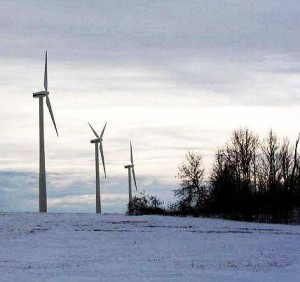Door County Opens for Wind Energy
- Share
- Tweet
- Pin
- Share
The Door County Board of Supervisors approved a revised Wind Energy ordinance Jan. 29 that pushes the door open, if only a crack, for the possibility of locally-generated energy on the Door Peninsula.
The ordinance, passed by a 17 – 3 vote, establishes the setback for wind turbines from inhabited structures to 1,000 feet, and cuts the allowable decibel level to 50 from 55 decibels. Those changes, according to John Hippensteel of Community Wind Energy, LLC, make “community-sized wind energy a possibility in Door County.”
The ordinance takes the place of one approved by the county in 1999 which essentially limited wind turbines over 170 feet to no more than a handful of spots on the peninsula.
Opposition to wind energy has focused on aesthetic and noise concerns, as well as worries about the impact the turbines would have on the flight patterns of birds. Hippensteel acknowledged the legitimacy of such concerns.
“They’re big, you’re going to see them,” he said. “Much of the opposition doesn’t like the look of wind turbines. You can hear them, but compare the noise to traffic, tractors, and even wind through pine trees and it’s not that bad.”
Wind energy advocates have pushed for action to ease the way for wind power in no small measure because they believe it can keep energy dollars from leaving the county and the state.
According to a 2005 article by Preston Schutt, Director of Business Development at the University of Wisconsin-Stevens Point, Wisconsin is a huge net loser when it comes to the energy economy.
Schutt wrote “the state has no deposits of fossil fuels, and must therefore import every unit of oil, gasoline, diesel, natural gas, propane and coal.” The State Energy Office estimated that in 2004, Wisconsin spent nearly $10 billion to import fossil fuels, or $4,600 per Wisconsin household. In total, nearly five percent of Wisconsin’s gross state product in 2004 left the state in the form of energy.
The state is trying to encourage wind power and renewable energy in general and Hippensteel said the change in Door County brings them in line with state statue. Wisconsin has set a goal of getting 10 percent of its energy from renewable resources by 2015.
Aside from the change in setbacks the new ordinance is considerably more restrictive than the old one, with decibel standards included and a critical communications study now required to make sure any wind development would not interfere with emergency services communication.
Hippensteel said despite the fact that the restrictions make developing wind power more difficult, he is ultimately in favor of such strict rules for development despite the fact that he said wind power is more closely scrutinized than other forms of development on the peninsula.
“I consider this ordinance representative of responsible development,” he said. “It may not be economically feasible, but it’s not impossible, and we’re willing to put the work in. My biggest fear is that it may open the door for big corporations from outside the county to come in who don’t have the best interests of Door County at heart.”
Sturgeon Bay Supervisor Ken Fisher was one of three board members who voted against the ordinance (Will Jeanquart and Chuck Gulley were the others), but he said he’s not anti-wind power.
“I really wasn’t against it, but I felt we as county board members had a responsibility to the townships,” he said. “If passed, anyone who wants to put one up could go get a permit right away before the towns get a chance to create an ordinance of their own. Then they’d be grandfathered in and the town wouldn’t have a say.”
Clay Banks, Fisher said, was proactive in addressing it first but other towns haven’t been getting involved. He said a two or three month delay until the ordinance would take effect would have given towns time to discuss and address how they want to handle it.
“I think wind power is a good idea,” he said. “I wouldn’t want to see one after another like the oil wells. I don’t think that’s what the tourists want to see when they come up here, but if it can be done right I’m for it.”
The next step for wind power is continued work on the feasibility study for a community-based wind project here, Hippensteel said.
“These things aren’t gold mines and most people would only do it because they believe in it, but it would help pay the bills,” Hippensteel said. “The energy dollars would stay in the county, and if we can produce more energy closer to home it’s a win/win. Done correctly it could be a good investment for Door County.”


